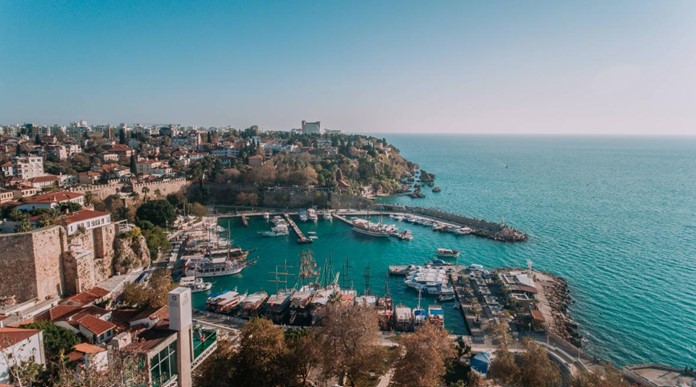It was in the 13th century that explorer Marco Polo introduced the gemstone we call turquoise to western Europe. He brought it from Asia Minor (today known as Türkiye), where it had been used for close to a millennium in tiles and jewelry. Later, as the Ottomans exported the “Turkish stone,” and textiles in “Turkish color,” to Europe, the stone became known as “turquoise,” a word which, to this day, in French, means “Turkish.”
Fast forward a century or two, and, just as the hues of gemstones such as “ruby,” “sapphire,” and “aquamarine” became synonymous in English for their rich colors, “turquoise” became the name we today call the blue-green color known to Pantone as 15-5217 TCX Blue Turquoise.
THE TURQUOISE COAST
But there is more to it. For the Aegean-Mediterranean coastline of the country of Türkiye is a modern-day Riviera, whose bays and inlets swirl with turquoise-colored water. Hence, this “Turquoise Coast” has today a double meaning: these are Turkish waters, and the warm sea is turquoise colored.
Today, the Turquoise Coast, which stretches south from Izmir and then west towards Antalya (pictured) and beyond, is one of the world’s most vaunted travel destinations. There are dozens of resorts along these shores, large and small, bustling and intimate. What each has in common are beaches lapped by turquoise-hued water that is both refreshing and warm. Antalya is the largest of these, reached by direct flights from Istanbul and countless European airports. Then there is Bodrum, which sits in its own bay, where resorts from mega- to micro-chic, draw Americans as well as Europeans. And, in between, there are tiny, and beautiful beach towns like Aspat, Yal?kavak and Gümü?lük. The exquisite bays of Alaçat? are a paradise for surfing in clear turquoise waters. Near Izmir, Çe?me stands out as one of the most popular destinations with numerous little bays and coves, sandy beaches and lively nightlife. And Ölüdeniz in Fethiye – noted for its blue lagoon – offers white sand beaches and turquoise waters, and is considered one of the most breathtaking natural spots in the world.
Many of these Turquoise Coast resorts are just a few miles from magnificent Roman amphitheaters and temples awaiting discovery by the 50 million visitors who come to Türkiye each year. And it is along this Turquoise Coast that Americans charter “gulets,” uniquely Turkish wooden sailing ships – from basic to luxurious – to cruise the coast and to be catered to by a professional team of sailors, captain, cooks and waitstaff. By day, gulets sail the waters and drop anchor for swimming, waterskiing and lunch; at night, each docks in a romantic harbor for a wharf-side dinner ashore.
Türkiye, www.goturkiye.com

